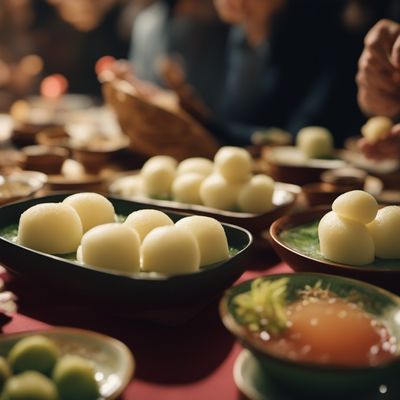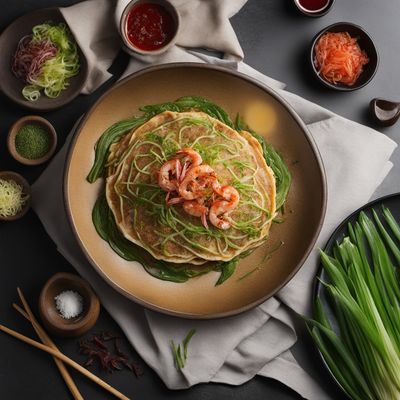
Recipe
Nizakana - Japanese Simmered Fish
Umami Delight: Japanese Simmered Fish with Fragrant Broth
4.6 out of 5
Indulge in the flavors of Japan with this traditional Nizakana recipe. Simmered to perfection, this dish showcases the delicate balance of umami flavors and tender fish, creating a comforting and satisfying meal.
Metadata
Preparation time
15 minutes
Cooking time
15 minutes
Total time
30 minutes
Yields
4 servings
Preparation difficulty
Easy
Suitable for
Pescatarian, Gluten-free, Dairy-free, Low carb, Low calorie
Allergens
Fish, Soy
Not suitable for
Vegan, Vegetarian, Paleo, Keto, Nut-free
Ingredients
-
4 sea bream fillets (200g each) or any other white fish fillets 4 sea bream fillets (200g each) or any other white fish fillets
-
2 cups (470ml) dashi stock 2 cups (470ml) dashi stock
-
1/4 cup (60ml) soy sauce 1/4 cup (60ml) soy sauce
-
1/4 cup (60ml) mirin 1/4 cup (60ml) mirin
-
1/4 cup (60ml) sake 1/4 cup (60ml) sake
-
1 tablespoon yuzu juice 1 tablespoon yuzu juice
-
2 tablespoons sugar 2 tablespoons sugar
-
1 thumb-sized ginger, thinly sliced 1 thumb-sized ginger, thinly sliced
-
2 green onions, thinly sliced 2 green onions, thinly sliced
Nutrition
- Calories (kcal / KJ): 250 kcal / 1046 KJ
- Fat (total, saturated): 5g, 1g
- Carbohydrates (total, sugars): 10g, 8g
- Protein: 40g
- Fiber: 2g
- Salt: 2g
Preparation
-
1.In a large saucepan, combine the dashi stock, soy sauce, mirin, sake, yuzu juice, and sugar. Bring the mixture to a gentle simmer over medium heat.
-
2.Add the ginger slices to the simmering broth and let it infuse for 5 minutes.
-
3.Carefully place the sea bream fillets into the broth, ensuring they are fully submerged. Cover the saucepan and simmer for 10-12 minutes, or until the fish is cooked through and tender.
-
4.Once cooked, remove the fish from the broth and set aside.
-
5.Increase the heat to high and let the broth reduce for a few minutes until slightly thickened.
-
6.To serve, place the fish fillets in individual bowls and ladle the hot broth over them. Garnish with green onions.
-
7.Enjoy the Nizakana with steamed rice and a side of pickled vegetables.
Treat your ingredients with care...
- Sea bream — Make sure to choose fresh sea bream fillets with firm flesh. If sea bream is not available, you can substitute it with snapper or any other white fish of your choice.
- Dashi stock — If you can't find dashi stock, you can make a substitute by dissolving 1 teaspoon of dashi powder in 2 cups of hot water.
- Yuzu juice — Yuzu juice adds a unique citrusy flavor to the dish. If you can't find yuzu juice, you can substitute it with a combination of lemon and lime juice.
Tips & Tricks
- To enhance the presentation, garnish the dish with a sprinkle of toasted sesame seeds.
- For an extra kick of flavor, add a small amount of grated daikon radish to the broth before serving.
- If you prefer a sweeter taste, increase the amount of mirin in the broth.
- Serve the Nizakana with a side of steamed vegetables for a complete and nutritious meal.
- Leftovers can be refrigerated and enjoyed the next day. The flavors will further develop, making it even more delicious.
Serving advice
Serve the Nizakana in individual bowls, ensuring each bowl has a generous amount of broth. Accompany it with steamed rice and a side of pickled vegetables for a traditional Japanese meal experience.
Presentation advice
To present the Nizakana beautifully, place the fish fillet in the center of the bowl and pour the hot broth over it. Garnish with a few slices of green onions and a sprinkle of toasted sesame seeds for an added visual appeal.
More recipes...
For Nizakana
More Japanese cuisine dishes » Browse all

Kinoko nabe
Mushroom hot pot
Kinoko nabe, or mushroom hot pot, is a traditional Japanese dish that is perfect for cold winter days. It is a hearty soup made with mushrooms and...

Kashiwa-mochi
Kashiwa Mochi
Kashiwa-mochi is a traditional Japanese sweet made of mochi (glutinous rice cake) filled with sweet red bean paste and wrapped in an oak leaf.

Kagoshima ramen
Kagoshima Ramen
Kagoshima ramen is a type of ramen that originated in Kagoshima, Japan. It is known for its rich and savory tonkotsu broth and thin, straight noodles.






